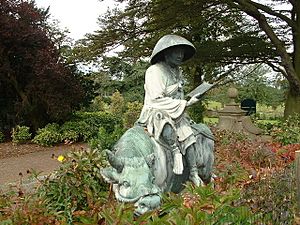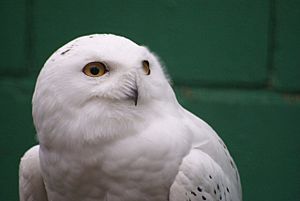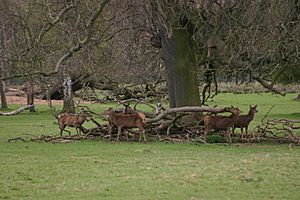Lotherton Hall facts for kids
Quick facts for kids Lotherton Hall |
|||||||||
|---|---|---|---|---|---|---|---|---|---|

Lotherton Hall, 2006
|
|||||||||
| General information | |||||||||
| Type | Country house | ||||||||
| Location | Aberford, West Yorkshire | ||||||||
| Country | England | ||||||||
| Coordinates | 53°49′06″N 1°19′07″W / 53.8184°N 1.3185°W | ||||||||
|
|||||||||
Lotherton Hall is a beautiful old country house located near Aberford in West Yorkshire, England. It's not far from the A1(M) motorway, about halfway between London and Edinburgh. Today, Lotherton Hall is part of the Leeds Museums & Galleries group, which means it's a museum and a fun place for everyone to visit!
This grand house has been around for a long time, at least since 1775. It was once a private home for several families. In 1825, a man named Richard Oliver Gascoigne bought it. His family, the Gascoignes, would own Lotherton Hall for many years.
After Richard Oliver Gascoigne passed away in 1842, his daughters, Elizabeth and Mary Isabella, inherited the house. Later, in 1893, Richard Trench Gascoigne became the owner. Lotherton Hall became the main home for the Gascoigne family after 1905.
During the First World War (between 1914 and 1918), Lotherton Hall was used as a special hospital for wounded soldiers. There's even a very old Norman chapel on the grounds, built in the 1100s, which was also used as part of the hospital after being fixed up.
In 1968, Sir Alvary Gascoigne and his wife, who were the last of the Gascoigne family to live there, gave Lotherton Hall to the City of Leeds. They wanted it to be a gift for everyone to enjoy. The house and its park opened to the public on August 6, 1969. This was exactly 25 years after Sir Alvary's only son, Douglas, was sadly killed in a tank battle during the Second World War.
Today, the estate is home to many interesting things, including a collection of rare birds and a group of red deer. There are big grassy areas perfect for games and picnics, and another field is used for exciting events like motorcycle shows.
The house itself was greatly changed and made bigger during the Victorian era and Edwardian times. It holds an amazing art collection, including many items given by the Gascoigne family. Since becoming a museum in 1968, more beautiful art and historical objects have been added. Lotherton Hall is also a special place where people can have wedding ceremonies.
Contents
The Gascoigne Family at Lotherton Hall
Lotherton Hall became part of the Gascoigne family's story when Richard Oliver Gascoigne bought it in 1825. He hoped his sons would inherit it, but sadly, both his sons passed away in 1842. So, when Richard died the next year, his daughters inherited the family's large estates.
The sisters divided the family's land in Yorkshire. Mary Isabella took Parlington Hall, and Elizabeth received Lotherton. Elizabeth Gascoigne and her husband, Fredrick Mason Trench, often rented out Lotherton Hall to other people. They preferred to live in their homes in Ireland. However, they did use Lotherton as their Yorkshire home for a while in the 1850s.
When Elizabeth passed away in 1893, her nephew, Colonel Fredrick Richard Thomas Trench Gascoigne, inherited Lotherton. He was a well-known soldier and traveler. During the time Lotherton Hall was rented out (from 1842 to 1893), different families lived there, as shown in old census records.
Colonel Gascoigne's wife, Gwendolen, was related to Florence Nightingale, the famous nurse. Colonel Gascoigne liked Lotherton Hall more than Parlington, so he moved many of the furnishings from Parlington to Lotherton. Parlington Hall was later taken down in the 1950s.
Between 1896 and 1931, the Gascoignes made many changes to Lotherton Hall to make space for their growing family. They added a dining room, an entrance hall, a drawing room, and a servants' area. Mrs. Gascoigne also designed and created the beautiful Edwardian-style gardens along the front of the house. Colonel and Mrs. Gascoigne had three children: Alvary, Oliver (who died as a baby), and Cynthia.
Sir Alvary Gascoigne, their son, became a British ambassador to countries like Japan and Russia. He inherited Lotherton in 1937 and lived there with his second wife, Lorna Priscilla Gascoigne. He brought many interesting artworks from Asia to the house during his time as an ambassador.
Sir Alvary and his first wife had a son, Douglas, who was killed in the Second World War. Since there was no one left to inherit Lotherton, Sir Alvary decided to give the hall to the City of Leeds in 1968. He wanted it to be open to the public. He also gave money to help buy more artworks for the collection. Sir Alvary passed away in 1970.
Lotherton Hall as a Hospital
The Gascoigne family was very patriotic and wanted to help during the First World War. In November 1914, Lotherton Hall was turned into a Voluntary Aid Detachment (V.A.D.) hospital for injured soldiers. Mrs. Gascoigne (Laura Gwendolyn Gascoigne) ran the hospital with the help of volunteer nurses and her daughter, Cynthia.
The hospital started with eighteen beds, but by the end of the war, it had thirty-five beds. From November 21, 1914, to March 28, 1919, a total of 655 soldiers were treated there. The Gascoignes paid for the hospital themselves and did not accept any money from the government. Colonel Gascoigne even volunteered as an ambulance driver on the front lines, and their son, Alvary, served in the army.
The local community and the St. Johns Ambulance Service greatly appreciated their help in the war effort. In 1918, Mrs. Gascoigne was given a special award called a CBE for her contributions.
Amazing Collections at Lotherton Hall
Lotherton Hall is home to about 3,000 objects spread across five different collections.
- The Gascoigne gift includes paintings, sculptures, furniture, silver, jewelry, and textiles. This collection was given to the City of Leeds in different stages between 1955 and 1979.
- The costume collection has historical and modern clothes and accessories.
- The Eastern pottery and porcelain collection mostly came from Frank Savery in 1966.
- The modern craft collection features ceramics, furniture, jewelry, and metalwork by famous British artists.
- The Cooper Collection is on loan from a private owner and includes Victorian and early 20th-century furniture and ceramics.
Famous Paintings
Some of the important paintings you can see at Lotherton Hall include:
- The Irish House of Commons (1780) by Francis Wheatley. This is a large painting showing a famous speech being made in the Irish House of Commons.
- Portrait of Sir Thomas Gascoigne (1779) by Pompeo Batoni. This painting shows Sir Thomas Gascoigne surrounded by books and sculptures, looking like a true art lover.
- Five Impressionist paintings by Joaquín Sorolla y Bastida from 1906, showing scenes of people on the beach.
- Four portraits and three landscapes by George Clausen, including The Miller’s Man (1888) and The Village at Night (1903).
- Works by other artists like Mark Senior, Philip Wilson Steer, and Edward Atkinson Hornel.
Unique Furniture
The furniture collection is also very special:
- Neo-Gothic designs by Augustus Pugin, including a footstool and dining chairs made for King George IV for Windsor Castle around 1828.
- A Neo-Gothic centre table designed by William Burges around 1867, with a beautiful marble top.
- A Neo-Gothic oak wardrobe designed by Collier and Plucknett, decorated with paintings of the seasons.
- An Art Nouveau high-backed chair designed by Charles Rennie Mackintosh.
- Arts and Crafts and Aesthetic Movement furniture by designers like Ernest Gimson and C. F. A. Voysey.
- Georgian furniture by Gillows of Lancaster, including a dining table made for Richard Oliver Gascoigne.
- Victorian marquetry designs by Charles Bevan, including furniture made for Titus Salt Junior.
Gascoigne Silver Collection
The Gascoigne family also had a wonderful collection of silver. This includes many horse racing cups from 1776 to 1842. Some famous ones are the Doncaster Cup from 1776 and a large silver cup from 1779 that celebrates two of Sir Thomas Gascoigne's most successful racehorses, Soothsayer and Jerry.
The collection also has a Communion Cup from 1628 and a silver plate from 1719. You can also see two old tankards, one from Sweden and one from Moscow, showing popular styles from different parts of Europe.
Small Portrait Miniatures
The Gascoigne gift includes ten tiny portrait miniatures. One interesting item is a snuffbox with a portrait of Marie Antoinette on it. Sir Thomas Gascoigne is even holding this snuffbox in his portrait by Pompeo Batoni, which is also on display. A very skilled miniature portrait is of Catherine, by Richard Cosway, a famous English miniature painter.
Chinese Ceramics
Lotherton Hall has impressive collections of Chinese ceramics from the Gascoigne gift and the Frank Savery bequest.
- The oldest pieces are from the Neolithic period (4th–2nd millennium BC), including decorated pots used for burials.
- From the Han dynasty (206 BC–AD 220), there's a tiger-decorated roof tile.
- The Tang dynasty (AD 618–906) is shown with grave offerings like a colorful camel and a realistic horse.
- Song dynasty porcelain (10th–13th century AD) includes a water sprinkler for a Buddhist temple and a duck-shaped water dropper.
- The Ming dynasty (AD 1368–1644) has a seated female figure and a wine jar with a scholar in a garden.
- From the Qing dynasty (AD 1662–1722), there's a beautiful vase with a detailed scene of warriors and people in a garden.
18th and 19th Century Pottery and Porcelain
You can also see Chinese armorial porcelain from the late 18th century. Sir Thomas Gascoigne ordered a dinner service and a tea service around 1770 and 1780. These pieces have the Gascoigne family crest (a pike's head) on them. While only a small part of the original sets remain, they are very special.
Other important ceramic designers and manufacturers on display include William de Morgan, Burmantofts Pottery, and Leeds Pottery.
Modern Craft Studio Pottery
Lotherton Hall has a small but important collection of modern studio pottery. This includes works by famous potters like Alison Britton, Michael Cardew, Hans Coper, Elizabeth Fritsch, Bernard Leach, and Lucy Rie.
The Medieval Chapel
The chapel at Lotherton Hall was built way back in the 1100s. It was a place of worship for the old village of Lotherton.
During the First World War, Colonel and Mrs. Gascoigne had it restored. It was used to house wounded soldiers and as a place for them to worship. Inside the chapel, there's a special memorial dedicated to the soldiers who fought and were treated at Lotherton. There's also a prayer desk inside the pulpit that was carved by the soldiers themselves as a way to help them recover.
Beautiful Gardens
The lovely gardens at Lotherton Hall were designed by Mrs. Gascoigne (Laura Gwendolen Gascoigne) in the early 20th century, before the First World War. Mrs. Gascoigne was a very talented gardener and had many famous gardening friends. The gardens have different sections, each with its own unique feel, matching the different styles of the rooms inside the house. At one end of the house, you can find a statue of Sho Haku, a Japanese holy man known for his love of peonies.
Amazing Wildlife
The bird gardens at Lotherton Hall opened in 1980. This area used to be the old kitchen gardens. In 1984, the bird gardens were made bigger and have become a very popular attraction. They are home to over two hundred different kinds of birds from six different continents around the world!
In 2003, a special walk-through aviary called 'Into Africa' was added, where you can see a mix of African bird species. The bird gardens celebrated their 25th anniversary in 2005 with even more new developments.
The deer park was created in the early 1980s. A group of deer were moved to Lotherton from another estate called Temple Newsam. Later, a herd of red deer was brought to the estate, and they are the only type of deer still living there today.
Visitor Statistics
Lotherton Hall is a very popular place to visit! In 2018, it attracted 453,335 visitors, making it the second most visited paid attraction in Yorkshire and Humber.
When Lotherton Hall started its "Christmas Experience" event between November 25 and December 23, 2016, a huge number of people came – 64,743! This was a big jump from 2015, when only 8,920 people attended during the same time. This popular event also led to many new memberships for Lotherton and brought in a lot of money for the estate. The Christmas event included a "Twelve Days of Christmas" walk through the woods and gardens, and an elf village with Santa's Grotto. In 2019, a new skating rink was also added, making the Christmas experience even more exciting.




